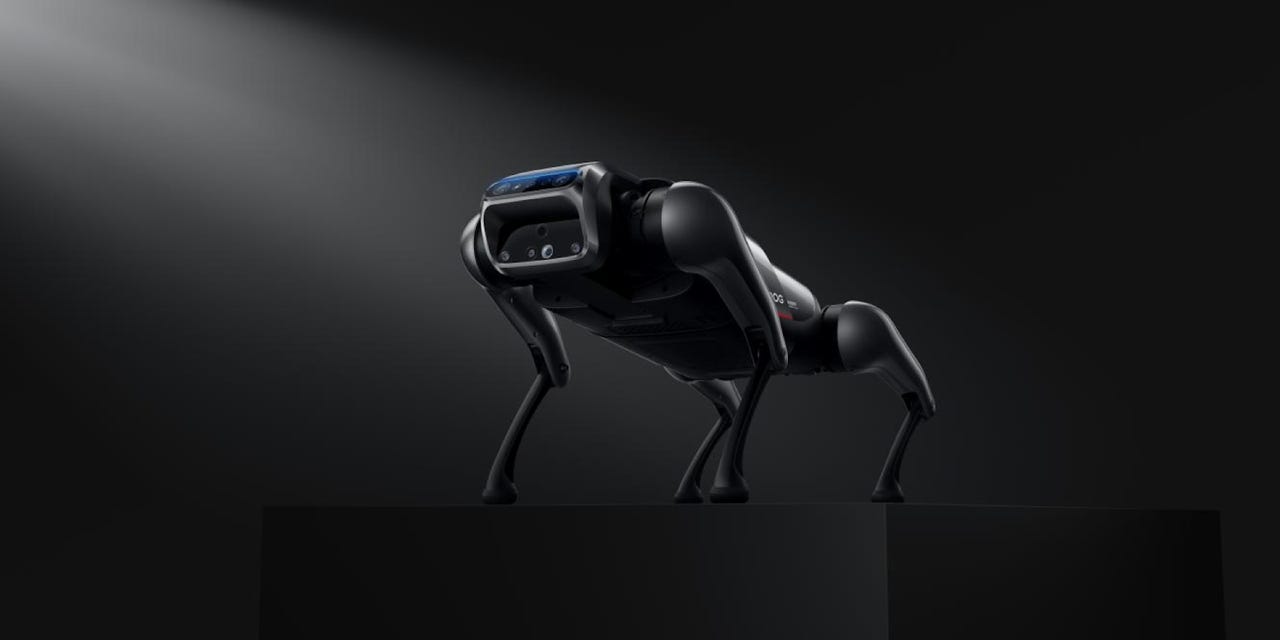Xiaomi enters quadrupedal robotics space with CyberDog


Xiaomi has unveiled a new quadrupedal robot called CyberDog, a machine that also marks the company's entrance into the four-legged robotics space.
According to Xiaomi, the new robot can conduct a range of high-speed movements up to 3.2m/s and complicated actions such as backflips. The robot can also respond to voice commands, including recognising wake words and instructions, and can be controlled using a connected smartphone app.
The actions are powered by the Nvidia Jetson Xavier NX platform, Xiaomi's "in-house developed servo motors", and 11 sensors.
Xiaomi explained that among the 11 sensors within CyberDog are touch sensors, AI interactive cameras, binocular ultrawide angle fisheye cameras, a depth module, ultrasonic sensors, and GPS modules.
The camera sensors, specifically, are trained with computer vision algorithms that allow it to perform autonomous object tracking, simultaneous localisation and mapping, and centimetre-scale obstacle avoidance and navigation, Xiaomi added.
Cyberdog also comes with three type-C ports and one HDMI port, which Xiaomi said were added to allow developers to integrate hardware add-ons or software systems more easily.
With Xiaomi claiming the robot is open source, it said lidar sensors, panoramic cameras, and search lights could all be added to the robot by users to allow more use cases for the CyberDog. Xiaomi has not said whether it will be revealing code to CyberDog users, only saying that the machine is "built upon open source algorithms".
As part of the unveiling, Xiaomi has made 1,000 units of CyberDog. Each CyberDog will be available for 10,000 yuan.
CyberDog is the latest entrant in the robotics market to embrace the quadrupedal form factor. The most well-known product in the market so far, the Boston Dynamics-built Spot, was made commercially available last year and has already been put to use to remind people about social distancing in parks and help healthcare providers remotely triage patients.
On the same day, Xiaomi also unveiled its latest flagship smartphone, the Xiaomi Mix 4.
The latest Mi Mix device has a full-screen display with a selfie camera located directly under the screen. The new display, labelled by Xiaomi as Camera Under Panel technology, is a 6.67-inch 120Hz 1080p curved OLED panel that has a 400ppi area around the camera to let light pass through.
The front camera itself is a 20MP sensor.
The rear camera system carries three sensors, which consists of a 108MP Samsung HMX sensor, 13MP ultrawide sensor, and an 8MP five-time periscope telephoto sensor.
Rounding out the hardware specs, Xiaomi Mix 4 comes with Qualcomm's new Snapdragon 888 Plus processor, 4,500mAh battery, sub-6Ghz 5G, and the options of 8GB or 12GB of RAM, and 128GB, 256GB, or 512GB of storage.
The smartphone's battery supports 120W wired fast charging and 50W wireless fast charging, which Xiaomi claimed will allow the device to fully charge in 28 minutes and 45 minutes, respectively.
The back of Xiaomi Mix 4 is a ceramic unibody and comes in three colours: Ceramic white, ceramic black, and ceramic grey.
Currently, the Xiaomi Mix 4 is only available in China and will retail from 5,000 to 6,300 yuan.
Related Coverage
- Xiaomi celebrates knocking Apple off to be the new number two
- Xiaomi's latest flagship smartphone has an AMOLED selfie viewfinder
- US agrees to remove Xiaomi from Communist Chinese military company list
- Xiaomi Q1 net profit jumps to 6.1 billion yuan from growth across all business segments
- Xiaomi to invest $10 billion into new electric vehicle business
- Xiaomi posts 246 billion yuan in revenue for 2020